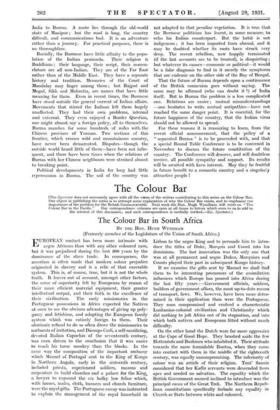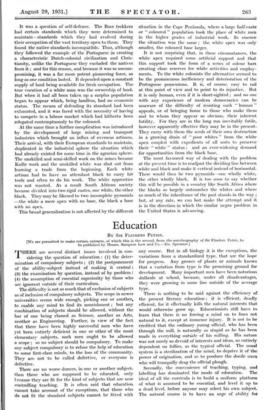The Colour Bar
[The Spectator does not necessarily agree with all the views of the writers contributing to this series on the Colour Bar: Our object in publishing the series is to attempt some explanation of why the Colour Bar exists, and to emphasize the importance of the problem for the British Commonwealth. Next week the Hon. Hugh Wyndham will write on "The Colour Bar in the Pacific." Our correspondence columns are open at all times to letters which seem to us to add to
the interest of this discussion; and such correspondence is cordially invited.—En. Spectator.]
The Colour Bar in South Africa
BY THE HON. HUGH WYNDHAM
(Formerly member of the Legislature of the Union of South Africa.) FIJROPEAN contact has been more intimate with .4 negro Africans than with any other coloured race, but it was prejudiced during the first 300 years by the dominance of the slave trade. In consequence, the assertion is often made that modem colour prejudice originated in slavery and is a relic of that execrable system. This is, of course, true, but it is not the whole truth. It leaves out of account, amongst other factors, the sense of superiority felt by Europeans by reason of their more efficient material equipment, their greater intellectual output, and their faith in the excellence of their civilization. The early missionaries in the Portuguese possessions in Africa expected the Natives at once to see the obvious advantages of giving up poly- gamy and fetishism, and adopting the European family system which was entirely foreign to them. Their obstinate refusal to do so often drove the missionaries to outbursts of irritation, and Dionogo Carli, a self-sacrificing, devoted Italian Capuchin of the seventeenth century, was even driven to the conclusion that it was easier to teach his tame monkey than the blacks. In the same way the composition of the important embassy which Manuel of Portugal sent to the King of Kongo in Northern Angola, early in the sixteenth century, included priests, experienced soldiers, masons and carpenters to build churches and a palace for the King, a lawyer to expound the six bulky law folios which, with horses, mules, cloth, banners and church furniture, were the royal gifts. The Portuguese envoy was instructed to explain the management of the royal household in Lisbon to the negro King and to persuade him to intro- duce the titles of Duke, Marquis and Count into his dominions. The last innovation was the only one that was at all permanent and negro Dukes, Marquises and Counts played their part in subsequent Kongo history.
If we examine the gifts sent by Manuel we shall find them to be interesting precursors of the assimilative influences which Europe has poured into Africa during the last fifty years :—Government officials, soldiers, builders of government offices, the most up-to-date means of transport, laws. We, however, have been more deter- mined in their application than were the Portuguese: They soon compromised and evolved a characteristic Lusitanian-colonial civilization and Christianity which did nothing to jolt Africa out of its stagnation, and into which both natives and Europeans fitted without much difficulty.
On the other hand the Dutch were far more aggressive at the Cape of Good Hope. They brushed aside the few Hottentots and Bushmen who inhabited it. Their attitude towards the more formidable Bantus, when they came into contact with them in- the middle of the eighteenth century, was equally uncompromising. The inferiority of colour was an article of their religion. Tant' Sannie considered that her Kaffir servants were descended from apes and needed no salvation. The equality which the British Government seemed inclined to introduce was the principal cause of the Great Trek. The Northern Repub- lican constitutions specifically forbade any equality in Church or State between white and coloured. It was a question of self-defence. The Boer trekkers had certain standards which they were determined to .maintain—standards which they had evolved during their occupation of the vast territory open to them. They found the native standards incompatible. Thus, although they followed the example of the Portuguese in creating a characteristic Dutch-colonial civilization and Chris- tianity, unlike the Portuguese they excluded the natives from it ; and for this reason, and because it was so uncom- promising, it was a far, more potent pioneering force, so long as one condition lasted. It depended.upon a constant supply of land being available for fresh occupation. The true vocation of a _white man was the ownership of land. But when it had all been taken up a surplus population began to appear which, being landless, had no economic status. The means of defending its standard had been exhausted, and it was faced with the necessity of having to compete in a labour market which had hitherto been relegated contemptuously to the coloured.
At the same time a further complication was introduced by the development of large mining and transport industries which brought an influx of overseas artisans. Their arrival, with their European standards to maintain, duplicated in the industrial sphere the situation which had already existed for some time in the agrarian sphere. The unskilled and semi-skilled work on the mines became Kaffir work and the unskilled white was shut out from learning a trade from the beginning. Each white artisan had to have an attendant black to carry his tools and often to do his work. The white apprentice was not wanted. As a result South African society became divided into two rigid castes, one white, the other black. They may be likened to two incomplete pyramids —the white a mere apex with no base, the black a base with no apex. - • This broad generalization is not affected by the different situation in the Cape Peninsula, where a large half-caste -or " coloured " population took the place of white men in the higher grades of industrial work. In essence the situation was the same ; the white apex was only smaller, the coloured base larger.
It is not surprising that, in these circumstances, the -white apex required some artificial support and that this support took the form of a series of colour bars creating close reserves for white activities and employ- ments. To the white colonists the alternative seemed to be the promiscuous inefficiency and deterioration of the Portuguese possessions. It is, of course, easy to rail at this point of view and to point to its injustice. But it is only human, even if it is short-sighted ; and no one with any experience of modern democracies can be unaware of the difficulty of resisting such " human " appeals, or of bringing home to those who make them and to whom they appear so obvious, their inherent futility. For they are in the long run inevitably futile, however apparently. effective they may be in the present. Theycarry with them the seeds of their own destruction in a growing drain of "poor whites" from the white apex coupled with expedients of all sorts to preserve • their " white " status ; and an ever-widening demand for opportunities from the black base.
The most favoured way of dealing with the problem at the present time is to readjust the dividing line between white and black and make it vertical instead of horizontal. There would then be two pyramids—one wholly white, the other wholly black. It is too soon to say whether this will be possible in a country like South Africa where the blacks so largely outnumber the whites and where so much of the inheritance of the past stands in the way ; but, at any rate, we can but make the attempt and it is in the direction in which the similar negro problem in the United States is advancing.



























 Previous page
Previous page